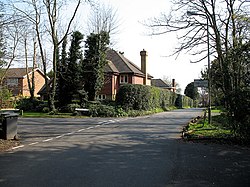Arkley
| Arkley | |
| Hertfordshire | |
|---|---|
 Arkley Lane | |
| Location | |
| Grid reference: | TQ225955 |
| Location: | 51°38’52"N, 0°13’52"W |
| Data | |
| Post town: | Barnet / London |
| Postcode: | EN5 / NW7 |
| Dialling code: | 020 |
| Local Government | |
| Council: | Barnet |
| Parliamentary constituency: |
Chipping Barnet |
Arkley is a village Hertfordshire, at the edge of the metropolitan conurbation, adjoining Chipping Barnet, which lies to the east, and itself to the east of Elstree. It is separated from Totteridge (also in Hertfordshire) by meadow and pasture.
Arkley consists of a long village strung out between Chipping Barnet and Stirling Corner, roughly centred on the "Gate" pub, and is composed of the ancient hamlets of Barnet Gate, Rowley Green and Arkley hamlet. Here stands one of the oldest windmills in southern Britain.
Name
The origins of the name Arkley are unclear; it is first recorded as Arkleyslond in 1332. The first element of the name appears to come from the Old English word (e)arc (or ark, meaning a chest), while the second element is from leag, a woodland clearing or glade. Thus the name Arkley would thus mean "woodland clearing by the ark or by the place where arks are made".[1]
History
It is thought by some that Hendon Wood Lane was originally a minor Roman road. Certainly the name, 'Grendel's Gate' (now Barnet Gate, and formally known as 'Grims Gate'), took a name borrowed from the monster from the Anglo-Saxon epic, Beowulf, though when that name was take is unknown. It was once a centre of a small but significant community, founded on a woodland economy.
The area is latter referred to in mediæval documents as 'Southhaw', and may have pre-dated the settlement at Chipping Barnet. Certainly, Barnet manorial court was held here in the 13th century. From at least the early 19th century until the 1890s, Arkley was commonly known as 'Barnet Common' or 'West Barnet'. The establishment of the civil parish [1] of 830 acres in 1894 confused matters further, as it was defined by the rural area around 'Barnet Town', and included places as far east as Duck Island and Underhill.
Local clay has been exploited for brick-making and pottery over the centuries. During the 1950s, a 13th-century kiln at Dyke Cottage was excavated, revealing a large cooking pot, and 19th century Ordnance Survey maps mark a "Tile Works".
A War Memorial was erected in 1920.
During Second World War, a listening post for German messages was maintained in the area.
In the 1970s, John Britten produced a small racing car named the "Arkley" in the area.
Parish church

The parish church is St Peter's. The church, designed by George Beckett, was built in 1840 as a private chapel at a cost of £5,000. The chancel was added in 1898.
The church contains a wall tablet of its benefactor, Enoch Durant, who died in 1848. After Durant's death the advowson was transferred to the rector of Barnet, and an ecclesiastical parish was formed in 1905.[2]
Windmill
Arkley Windmill was in use by 1806. It is marked as corn windmill on an Ordnance Survey map of the 1860s. From photographs, it appears to have had only two of its original sails by the 1890s, by which time it may have been powered by steam. It ceased to be a functioning mill during the First World War. It was restored in 1930, but not as a working mill.
The Gate Inn
The Gate Inn retains some of its original features. The sign, in the form of a hanging five bar gate, has an inscription which reads:
This gate hangs high,
and hinders none;
refresh and pay,
and travel on
According to the old article displayed on one of its walls, The Gate was once visited by Anna Pavlova and her dancing troop. Until the early 1960s a large tree grew up from the floor of the pub and out through the roof.
Nature reserves
For its size, Arkley has several 'Sites of Importance for Nature Conservation', cappropriately for its position guarding the first green land outside the swollen conurbation whose edge reaches the village. The designated areas are:
- Arkley Lane and Pastures
- Arkley South Fields
- Barnet Gate Wood
- Glebe Lane Pastures
- Rowley Green Common
- Rowley Lodge Field
- Totteridge Fields and Highwood Hill
In addition, Dollis Brook and Folly Brook, which are also 'Sites of Importance for Nature Conservation', rise in Arkley.
Sort
- Golf: Arkley Golf Club, founded in 1909 and whose course was designed by James Braid and Harry Vardon.
Outside links
| ("Wikimedia Commons" has material about Arkley) |
- Early directories use the Victorian name, Barnet Common or West Barnet, for 'Arkley'.
- Research articles
- Barnet Archives and Local Studies
- Barnet Museum
- Chipping Barnet Library
- Hertfordshire Archives & Local Studies
- HADAS Archived Newsletters - The Hendon & District Archaeological Society
References
- ↑ Mills, A.D. (2010). A Dictionary of London Place-Names. Oxford University Press. p. 8. ISBN 9780199566785.
- ↑ "St Peter's Church, Arkley". London Parks and Gardens Trust. http://www.londongardensonline.org.uk/gardens-online-record.asp?ID=BAR081. Retrieved 3 April 2013.
